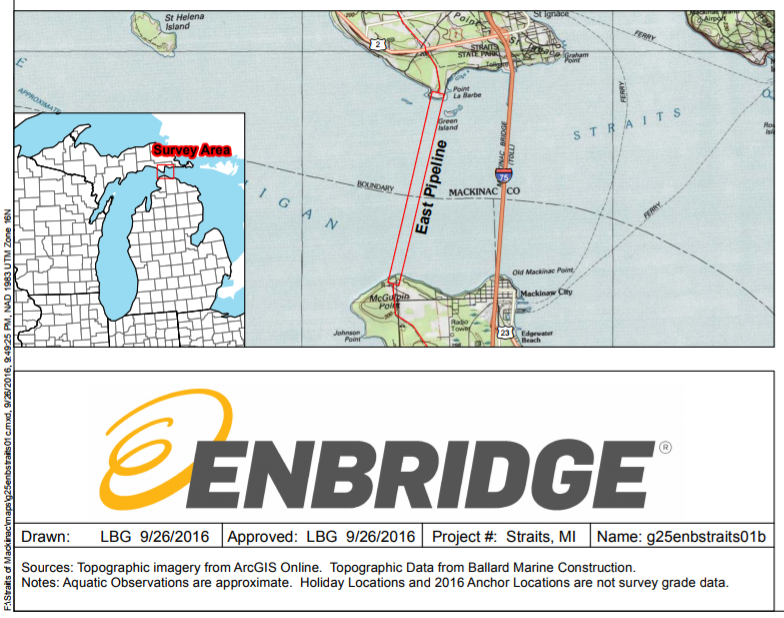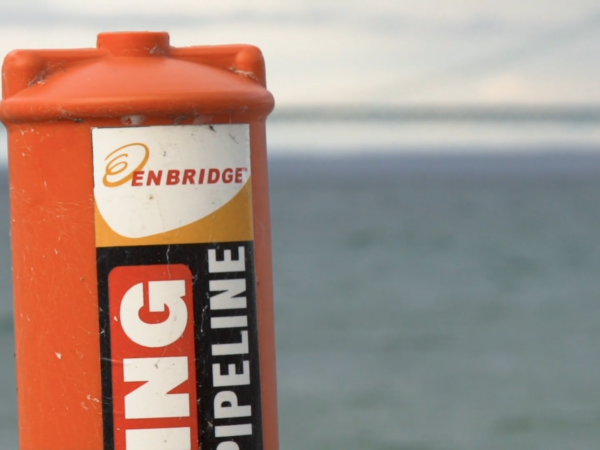
State officials briefed reporters on a conference call today about the agreement with Enbridge Inc. for pipeline improvements, and then the reporters had plenty of questions.
Here is an edited version of some of the inquires along with the state officials’ answers. Follow the links to the published stories, where possible, and the media outlets’ websites.
Question: How does the agreement guarantee against oil spills into the Great Lakes? From Cheyna Roth, Michigan Public Radio Network
Answer: A new pipeline would be constructed inside a tunnel 100 feet below the bottom of the Straits. This ‘extra’ housing around the pipeline would be “secondary containment” if the 30-inch pipeline leaked. The existing lines would be deactivated and no longer used. Environmental groups have concerns that having both a pipeline and electrical lines in a tunnel could cause explosions.
Question: How is that risk addressed? From Jim Malewitz, Bridge Magazine
Answer: Those issues will be considered as tunnel is constructed. Previous analyses have found that the risks can be mitigated.
Question: Is this agreement a commitment from Enbridge? From Jacob Kanclerz, MIRS
Answer: It’s the state’s position that it calls for the construction of the tunnel. There is, however, the need for approval and contracts with the Mackinac Bridge Authority.
Question: Is there a cap on what Enbridge needs to or would spend on the project across Michigan? From Jonathan Oosting, Detroit News
Answer: There is not an upper cap on the agreement at this time.
Question: To what extent does this agreement apply beyond the Snyder administration? From Andy Balaskovitz at Midwest Energy News
Answer: This agreement is predicated on a future agreement with the Mackinac Bridge Authority and meeting some environmental statutes, but this plan is a step toward that.
Question: To clarify, the existing pipeline carrying oil and natural gas will stay open during the construction of the tunnel and its replacement pipeline? From Jacob Kanclerz, MIRS
Answer: The existing pipeline will remain open but with safeguards including improved monitoring of wave heights, the addition of personnel who could manually close valves, and other additional emergency response capabilities.
Question: How will decommissioning of the existing line be handled? From Cheyna Roth, Michigan Public Radio Network
Answer: Officials will determine the best decommissioning strategy with attention toward environmental outcomes. No specific protocols have been determined.
Question: What agencies or stakeholders have been consulted about the proposal?
Answer: Officials have had preliminary and cursory conversations with the EPA and the U.S. Coast Guard.
Question: Has there been a similar project of this scope anywhere else that you can use for comparison and information? From Keith Matheny, Detroit Free Press
Answer: The Chunnel under the English Channel is an example of existing infrastructure. State officials have a high degree of confidence that it’s doable.
Question: Could a new governor legally undo the agreements, if they are in place by the end of the year? From John Flesher, The Associated Press
Answer: It is currently the state’s intention to have legally binding agreements in place before a new governor takes office.
Question: What is the possible timeline for construction? From Michael Kransz, Grand Rapids Press
Answer: State officials estimate that within seven to 10 years, the tunnel and its pipeline will be finished.
Question: How were some of the Michigan’s Native American tribes included in the discussions? From Sandra Svoboda, Great Lakes Now at Detroit Public Television
Answer: State and company officials consulted with tribes last week. The proposal addresses some of their concerns: increased stewardship along the line, a $1.8 billion financial security from the company, for example. But not all tribal issues were addressed, and discussions will continue.




